Gluten-Free Crusty Boule
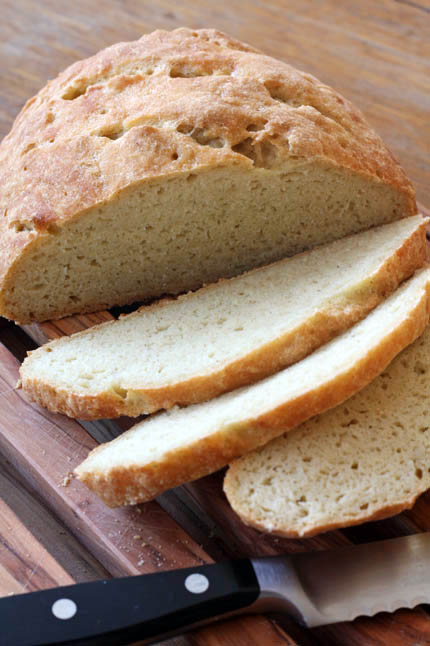
Gluten-free breads were a major request from readers of Artisan Bread in Five Minutes a Day. The options for buying gluten-free bread are both unsatisfying and expensive. So here is a wonderful bread that anyone, celiac or not, would want to eat.
Several readers have asked about the olive oil dough on page 302 of The New Healthy Bread in Five Minutes a Day. While the Crusty Boule (page 299 in the book) has a chewy and toothsome texture, the bread made with the olive oil dough has a much lighter, almost fluffy interior. Replace the neutral flavored oil in the Gluten-Free Crusty Boule recipe with olive oil if you prefer the texture of that loaf. They are both wonderful and give you fantastic options for free form loaves, sandwich breads, pizzas and even crackers. You will find all of these, plus many other gluten-free breads and awesome sticky buns in the book, with the link above.
For those of you who are celiac or just baking for someone who is you will find all of the directions and tips for handling gluten-free dough below. It is just as easy as the other recipes, but requires slightly different techniques and a new list of ingredients.
Gluten-Free Crusty Boule
Makes enough dough for at least four 1-pound loaves
2 cups Brown Rice Flour
1 1/2 cups Sorghum Flour
3 cups Tapioca Flour (also called tapioca starch)
2 tablespoons yeast (can be reduced but you will have to increase the rise time)
1 tablespoon kosher salt (increase or decrease to taste)
2 tablespoons Xanthan Gum
2 2/3 cups lukewarm water
4 large eggs, whisked together
1/3 cup neutral-flavored oil or olive oil
2 tablespoons honey or sugar
Click here to see the video of this recipe

Mixing and storing the dough: Whisk together the flours, yeast, salt and xanthan gum in a 5-quart lidded Round Food Storage Container. Combine the oil, honey and water, set aside.
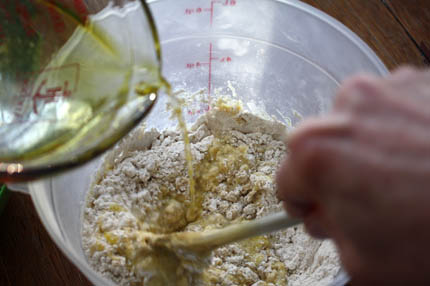
Dump the eggs into the dry ingredients and then stir while you pour in about 1/3 of the oil and water. Unlike my wheat doughs, do not add all of the liquid at once and stir. If you do, that will result in a lumpy dough.
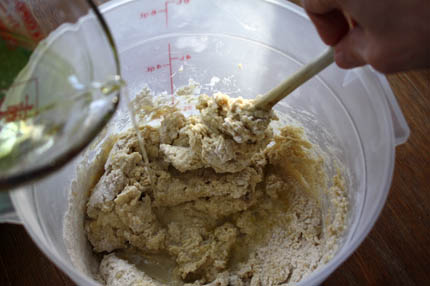
Continue to stir while you pour in another 1/3 of the liquid.
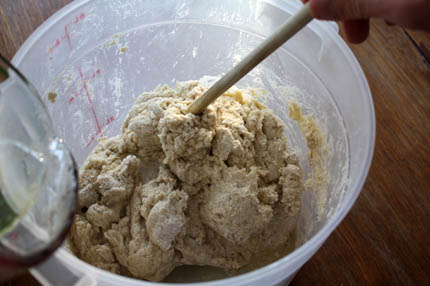
The dough will start to come together in a thick dough. Add the final 1/3 of liquid and
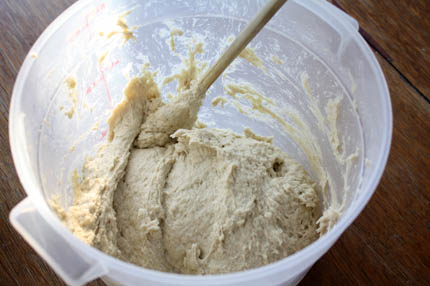
Stir until the dough is smooth. Cover with the lid, but do not snap it shut. Allow it to rest on the counter for about 2 hours. Place the dough in the refrigerator and store for up to 7 days. (I have a piece in the freezer and I will report back about how that turns out once I defrost it and bake it up. Stay tuned.)

On baking day take the bucket from the refrigerator. The dough will be quite fluffy still and you want to try not to handle the dough too much. Just like our other doughs the trick is to keep as much of the air bubbles in tact as possible.
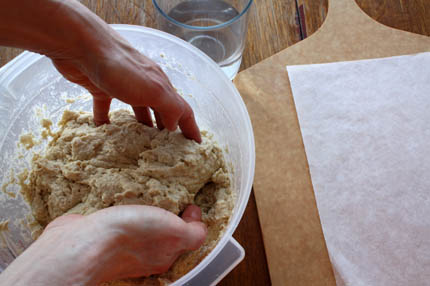
Use wet hands to remove 1-pound (grapefruit-size) piece of dough from the bucket.
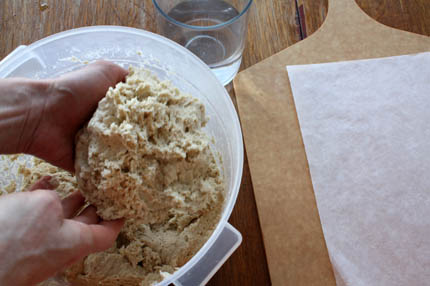
The dough will be quite scraggly when you take it out, just place it on a piece of parchment paper.
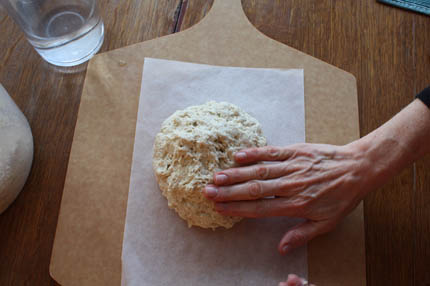
Use wet hands to smooth out the surface of the dough.
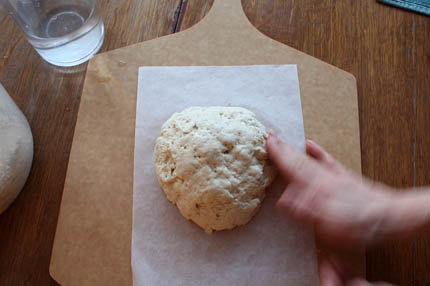
This may take dipping your hands in the water a few times…

to get a nice shape.
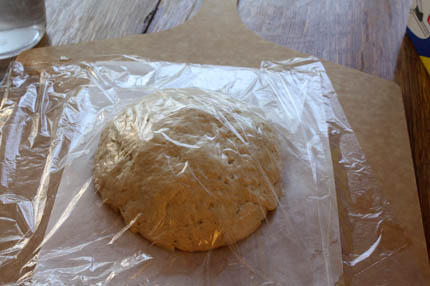
Cover loosely with plastic wrap and allow to rest on the counter for about 90 minutes. If your kitchen is very warm you may only need about 75 minutes.
30 minutes before baking time preheat the oven with a 5 1/2 quart Dutch Oven in it to 500 degrees. Be sure it is fitted with a metal Replacement Knob
, the original plastic knobs can only be heated to about 400 degrees. To find directions for baking on a stone see page 237 of HBin5.
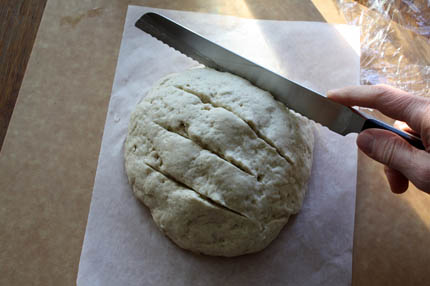
The dough will not have grown much while resting, but it will seem a little bit puffier. Use a serrated knife to cut slashes in the dough.
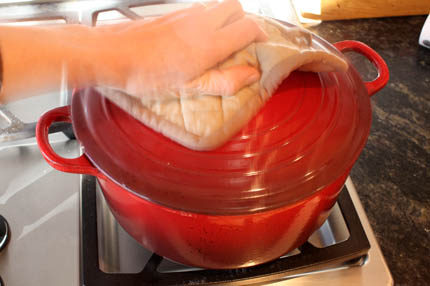
Remove the pot from the oven and take off the lid.

Lift the bread on the parchment and VERY CAREFULLY lower the parchment and bread into the pot, replace the lid onto the pot. Return to the oven and bake for 20 minutes. After the 20 minutes remove the lid, turn the heat down to 450 and bake for an additional 15 minutes.

Once the bread is done baking remove it from the pot using a spatula.
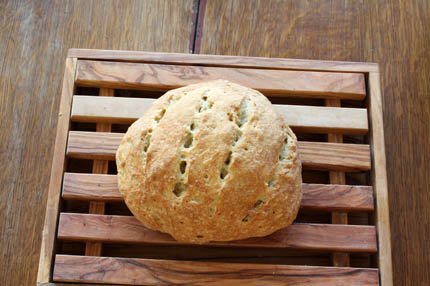
Allow the bread to cool completely before eating or the center may seem gummy.
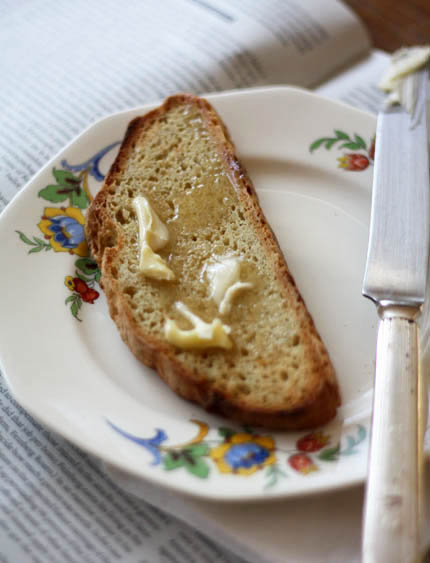
WEIGHTS for GLUTEN-FREE FLOURS
Brown Rice Flour: 1 cup = 5 1/2 oz = 155 grams
Tapioca Flour (Starch): 1 cup = 4 1/2 oz = 130 grams
Sorghum Flour: 1 cup = 4 3/4 oz = 135 grams
Cornstarch: 1 cup = 4 1/2 oz = 130 grams
Note: BreadIn5.com is reader supported. When you buy through links on the site, BreadIn5 LLC earns commissions.
Your link for the “5 qr lidded food storage container takes me to AMZ and a 1 qt set. Do I need to buy the 6 qt set? There is no 5 qt set.
Also:
Can I cut this recipe in half and use a 4-5 qt covered glass bowl instead?
Thanks
Hi. You can cut the recipe in half. In which case you can use a smaller container.
If you make a full batch, then you want a container that is at least 5-quarts, but the cambro brand comes in 6-quarts.
Thanks, Zoë
Liked your boule
very much
I made this bread. It was great. How did freezing one turn out. Please. I am only one in family on a gluten free food plan. Thank u. Please send updates
Just wrap well, as airtight as you can get it before freezing.
Thank you so much for sharing this recipe! For so long I have avoided gluten-free bread but this recipe is wonderful! It was so easy to follow and the finished product is delious! I love the crisp outside and soft middle… so good and I’ve been drizzling honey on it. This goes down in history as one of my favorite gluten-free recipes. I can’t wait to try the others! :]
Thanks for the kind words, Tori. We have a whole book of GF recipes, you can click on the book-image above…
Can you be more specific as to the book of gluten free breads? I cannot find it among all the listings of so many books that seem to be just regular bread cookbooks. thanks.
Sorry, it’s here on Amazon: https://amzn.to/1msOBmY
Please advise if possible to use an already purchased gluten free flour (King Arthur) and if so, what is the quantity? Thank you so much.
Kat
We had no luck with any of the mixes, but I have to admit, we did not test with KAF, so if your experiments are successful, please let us know. Unfortunately, we found that the mixes worked well for sweet things risen with baking soda/powder etc, but not yeast. Especially when you store the dough like we do.
I’ve used both KAF, Bob’s Red Mill 1:1 and the mix as recommended, and had great results with all. Ultimately, I’ve made the bread often and always use what I have. Love this bread, and made it bunches of times. Even people who eat gluten eat it without comment.
Hi Kate,
Thanks for the note, that is great to know.
So glad you are enjoying the bread! Zoë
Hi!
I would like to know if it’s possible to use psyllium husk instead of the gum?
Thank you!
Yes, ground psyllium husk, though we haven’t tested it in this exact recipe. Details are in our GF book, on Amazon at https://amzn.to/1msOBmY
Also some materials here on the site.
I only use psyllium husk powder in this recipe. It works great but you need to add twice as much as the gum.
Mary O.
Thank you very much Mary and Jeff for the helpful information!
Hi, I’m new to bread baking especially gluten free and am in England. Do you use fresh yeast or can I use dried packet, in either case wondering about quantity. Also cup measurements for liquids, can you tell me in mls please as I believe uk and US cups are different. Thank you.
Hi Lyn,
We tested all of our recipes with Dry yeast. We have all the recipes in weights in the book. You’ll need 10g dried yeast and 850g water.
Thanks, Zoë
Recently switched to GF and I’m so thankful to find artisan bread options. It was one of the things I was mourning the most! Question for you – one of my favorite breads is a raisin and pecan. Could I add those to this recipe? Would I need to make any adjustments to the recipe?
In our GF book (on Amazon at https://amzn.to/1msOBmY), you’ll find several recipes with raisins and/or nuts:
Cinnamon-Raisin Bread
“Pumpernickel” Raisin-Walnut
Raisin-Walnut Oatmeal Bread
… but, it’s not just a matter of putting raisins and nuts in the basic Master Recipe, which is all we’ve provided here on the web…
Hi can u please tell me if I should freeze before cooking or after? I have hypothyroid & finding out I have 2 go gluten free looking 4 new recipes & ways 2 cook.
Either works, but don’t freeze for too long. I prefer freezing dough, not bread. Defrost overnight in fridge before using.
Wow. This is the BEST gluten free bread recipe I’ve ever tried. Thank you. Thank you. Thank you. It was delicious hot AND cold. It is truly the perfect recipe. I will not be buying store bought GF bread anymore.
Fantastic, thanks Ursula. Check out the whole book at https://amzn.to/1msOBmY
I use 4 Cup Flour which comes baged and has the xanthum gum already in it. Has worked great.
Hi Cathy,
Thanks for letting us know. Do you mean Cup 4 Cup flour? If so, which one are you using? This info will be very helpful to our other readers.
Cheers, Zoë
Hi Cathy,
Did you omit the xanthum gum in the recipe altogether then, since your mix contains it? I want to use Arrowhead Mills Heritage Blend GF flour, which also includes XG, and am searching everywhere for the answer…
Thanks!
Hi Elara,
I would start with small batches of dough when experimenting with new flour blends. I found that some of them contained a sizable amount of xanthan, which meant I didn’t add any additional or it got gummy. But, others had hardly any added and the dough didn’t hold together. It is really a matter of trial and error.
Thanks, Zoë
Hi Zoe!!! I have a question. In my country you can’t find sorghum flour. Can I replace it? Thank you so much!! 😉
FYI: This can be ordered on Amazon.com Bb’s Red Mill is a good brand
Hi Silvia,
You can also use oat or amaranth flours instead of sorghum. If those are not available, you can also try brown rice. Try making a half batch to make sure you like the flavor and texture.
Thanks, Zoë
Hello again! Thanks for responding Zoë!!! I have another question! Can I replace the eggs? I’m vegan. What are the options? Thanks again!! 😉
Hi Silvia,
Our readers have had good luck with egg replacers in the recipes. I have made the recipe with flax as well: https://artisanbreadinfive.com/2010/06/01/gluten-free-baguettes-egg-free-and-a-king-arthur-gluten-free-flour-giveaway
Thanks, Zoë
Ok thank you!!! I got it!! Another question hehehehe sorry for been such a pain!!! The only tapioca I found is called Minute Tapioca. Will that works?
Hi Silvia,
Is that a flour or small tapioca balls? If it is a flour, I think it may work, but I’d start with a half batch just to make sure.
Thanks, Zoë
As the recipe calls for a “grapefruit size” piece of dough for a single loaf, does this mean I should expect the finished loaf to be the size of a grapefruit also as it doesn’t rise much (ie. 5-6″)?
Hi Sue,
The loaf will get some oven spring as it bakes, but it will not rise as much as a wheat bread. It will be slightly bigger than a grapefruit.
Thanks, Zoë
This was pretty good, but I found that each time I baked a loaf the inside was wet and gummy even though it had baked to 200 degrees and beyond. Do I need to add more flour?
Hi Julie,
Are you using any substitutions in the recipe? Are you waiting until the loaf is completely cooled before cutting it? I’ve found this is even more important for GF breads.
Thanks, Zoë
I used a sprouted brown rice flour instead of regular brown rice flour but I did let the bread cool completely. Even though the internal temperature of the bread was 200 plus, the crust was only a very light brown. Do you think I should just let it cook longer?
Hi Julie,
The sprouted flour may be the reason your bread is not coming out as well. We find that GF flours all behave very differently and even switching from one brand to another can produce a very different loaf. You may just need to experiment with the amount of water you use? You can also try letting it bake longer next time and at a slightly higher temperature, especially if it is not getting any color on the crust.
Thanks, Zoë
I want to try this bread but only have a stone. Before investing any more in equipment since I’ve had to be gluten free, do u have the directions for using a stone on your website versus the Dutch oven?
Hi Kelly,
Here is a video that shows the bread being baked on a stone: https://artisanbreadinfive.com/2015/03/03/gluten-free-bread-in-five-minutes-a-day-the-video
Thanks, Zoë
Is there somewhere the nutritional value of the bread is posted?
Not exactly, our publisher hasn’t funded that in our books. So, type “nutritional information” into our “Search Site” box above and click on the first result– you can use that to calculate the nutritional value of a full recipe, then divide by the number of servings…
I’ve made the recipe from your website several times with big success. This is the recipe. https://artisanbreadinfive.com/2010/01/05/gluten-free-crusty-boule
I now have the gluten free artisan bread in 5 book and tried out the master recipe on page 64 with very dense results. I did sub brown rice for the white rice flour but tried a few times as is and with added water only to result in a dense loaf every time.
I’m wondering if the flour mix with tapioca instead of potato starch is the culprit considering I actually weighed the flours for the book recipe. Do you think the other recipes from the book would work with the flour mixture from the website recipe? I’m dying to try several of them but am hesitant to produce more duds.
Well, the most likely explanation is: eggs. They really help. Egg whites in particular. If you make the variation on page 73–I think you’ll be happier.
You can try the website recipe for the flour mix–but I don’t think that’s it.
I noticed at the bottom there’s an update with the weights of the flours and you’ve included cornstarch. Is the recipe supposed to have cornstarch in it too?
Hi Amber,
No, it is just there because some folks can’t get ahold of tapioca, so they substitute corn starch.
Thanks, Zoë
Love that you tested this recipe for us! I can’t wait to try it… have you baked with chia seeds? Ive used them in place of some gums and wondered if it might also work here. Thanks!!
Well, we did, and have to admit that our experiments with chia were not a success, so we didn’t include that in our GF book (on amazon at https://amzn.to/1msOBmY). Who knows though, maybe we didn’t handle it right, maybe we gave up too soon, but it was just too dense. If you have success with that in your own experiments, please let us know here.
This recipe is wonderful…made it three times…now I’m about to try making crackers with it, any suggestions? I grew up on, Excelsior Genuine Jamacian Water Crackers, so I’m trying to get as close as possible. Their ingredients are basic, wheat flour, salt, leavening agent, and yeast.
Hi Deseree,
If you press and roll the dough out between an oiled piece of parchment and plastic wrap you can get the crackers very thin. Carefully peel up the plastic and bake right on the parchment. The instructions are in our GF and/or our pizza books.
Thanks, Zoë
Hello.. I have a yeast allergy as well as being Celiac. Can you please tell me which of your recipes work well with Baking Powder instead. I bought your book and really want to make some delicious bread.
Thanks
Donna (UK)
Hi Donna,
All of our recipes are yeast based and we’ve never tested with baking powder. The chemical properties of baking powder would not allow you to store a dough for more than several hours without losing the rising power. You want to look for “quick bread” recipes if you can’t use yeast.
Thanks, Zoë
Should I seal the lid when putting in fridge? My dough rose up very high, but shrunk overnight while in fridge. The resulting bread was good, but dense. What can I do so that bread stays risen?
No, that’s the way our dough behaves, it’s normal. Which of our recipes are you using (which book, which page number)?
Ok, I’m not sure what I did, but I halved the recipe (1 cup brown rice flour, ground fine in my VitaMix, 3/4 cp B’s Red Mill”sweet white” sorghum flour, 1.5 cps of tapioca starch, 1 T. chia seed, instead of the Xanthum Gum, 1T yeast, 1/2 T kosher salt, 2 eggs, 1 and 1/3 cp water,1/6 cp oil, 1T honey) and it came out soupy! Not like dough at all :(. I added half the amounts of flours again, but it’s still a very wet dough (not something I could grab a piece of). Does the chia/xanthum gum exchange really make that much of a difference? Or did I do something else wrong? I sure hope I didn’t just waste a bunch of rather expensive flours :(.
We found that our recipes just don’t work with chia seed– it is not a good swap for xanthan.
It’ll still make good flatbread– roll it out and see what you think!
What is the minimum time that I need to leave it in the refrigerator? I just mixed this up and it’s rising on the counter. I’m wondering if I can bake it tonight, or should wait until tomorrow.
Which book are you working from (which page number, which recipe)?
https://artisanbreadinfive.com/2010/01/05/gluten-free-crusty-boule This link uses a Tramontina D oven: have you been using it at
500* regularly for boule loaves? the manufacture says only 450*. Just wondering, as I want to try 500*, as you’re getting GF recipes, best results at 500*, and I will return the Tramontina for another, if it shouldn’t be used at 500* thanks, C.O.
Hi Cheryl,
The pot that I am using in this post is a Le Creuset Signature Enameled Cast-Iron 5-1/2-Quart Round French (Dutch) Oven and it is rated to go to 500°F, and if you replace the knob, it can likely go higher. It may be the knob on your Tramontina D oven that prevents you from using it at higher temps? If so, you can get a metal replacement knob.
Thanks, Zoë
Do you need to put the dough in the fridge before baking?
Hi Magi,
You don’t have to, you can bake right after it rises. If you have our GF book, there are instructions on page 68.
Thanks, Zoë
No, I don’t have the book. I was asking for clarification of the recipe you posted online. It isn’t complete, and the instructions are different from the video.
Hi Magi,
We have several books with gf chapters, so there are a few different recipes on the site and videos to match. You can bake any of them before refrigerating, they just require different rise times after shaping than if you are using chilled dough. It is generally about 1/2 as long.
Thanks, Zoë
Hi, we just got the book, and it says to use water that is 100 degrees. However , on the yeast package it says to use water that is 120 degrees . What is the reason you say 100? By the way, it was delicious!
Hi Robin,
As long as your water is not hot, you can use warm (up to 120°F) or you can use cold water. Some people like the flavor when they use ice water because it slows down the fermentation process. We decided on lukewarm, slightly lower than 120° since most of our readers are not using a thermometer at all.
Thanks, Zoë
Hi Jeff and Zoë
My name is Tatiana and I’m from Brazil. I’ve been gluten intolerant for a couple of years and so has my sister. We’ve been strugling to find good breads here at home (market is not aware of us yet!)and for our joy I found your website last week. I tried this recipe yesterday and it was absolutely amazing. Thank you so much for sharing that with us. You changed our lives! Ingredients are not easy to find here, but I managed to do it and I’m now doing my second batch of breads!
Thanks once again 🙂
Tatiana
Hi Tatiana,
Thank you so much for the lovely note, we are so glad you are enjoying the bread!
Cheers, Zoë
Thanks for the recipe! Do you think it would work with a normal oven?
Sure. Much more on GF in Gluten-Free Artisan Bread in Five Minutes a Day (on amazon at https://amzn.to/1msOBmY)
Do I need to use all the water? My dough is really wet after adding 2 cups of water. Thanks!
Which of our recipes are you working from? Which book/page number?
I was trying to make Gluten-Free Crusty Boule. Thanks!
Well, we have a number of those in several different books–which book, and which page number?
It’s this recipe https://artisanbreadinfive.com/2010/01/05/gluten-free-crusty-boule
Thanks!
Can adjust water, definitely if swap flours. Much more info in our books…
Great. Except I don’t have a dutch oven and there are no pages to turn so where do I find the directions for baking this on a pizza stone?
Hi Jennie,
The Master recipe from our book bakes on a stone, so the instructions should be right there. The Dutch oven is just an alternative to try.
Thanks, Zoë
This gluten free bread is fabulous! I have now made several batches and am wondering if I could put the dough straight into the loaf pans from the first mix. The 2 hours for the dough to rise is the best. When I cut it to place into the loaf pans for the second rise, it does not rise as much as the first time. I would leave it for several hours of course in the pans before placing into the heated oven. Do you think there would be a problem with this method?
Thank you for your wonderful book Gluten Free Artisan Breads in 5 Minutes.
Judy
That should be OK, yes…
Hi!
May I sub sorghum flour for oat flour?
Thanks!
Hi Fernando,
Do you have our GF book? If so, all the substitutions are on page 61. You can substitute sorghum for oat flour.
Thanks, Zoë
Excellent recipe, thank you! My family didn’t even know it was gluten free. I am making bread again today to enjoy this weekend.
Fantastic!
Hi,
nice recipe, wonderful GF bread. My mistake – forgot add salt… can I add salt to the remaining dough which is now resting in fridge?
thanks a lot,
Hi Martin,
Yes, you can. You’ll need to let the dough rest longer when you shape the dough to get the rise back into the dough.
Thanks, Zoë
Thanks a lot, will try
Martin
You didn’t say what kind of yeast, instant, active ? Regular?
Hi Adreana,
It doesn’t matter, you can use any of them! Because our dough is meant to be stored for several days, it all turns out to behave the same over time.
Thanks, Zoë
Hi
Can you tell me how this is for sandwiches? Is it crumby or dry at all?
Thank you!
Hi Rachel,
I think it’s great, but all gluten-free breads stale very quickly, so you either want to make small loaves or slice and freeze the bread.
Thanks, Zoë
Help! Is there a cup-for-cup replacement for rice flour? I cannot tolerate rice. It is to inflammatory. I think maybe because of the arsenic in it. Anyway how can I make this amazing recipe if I cannot have rice? Please advise. That crusty bed is all I am thinking about today.
Liza: We simply could not succeed without the rice flour, and never found a good swap!
I saw the glutten free Crusty Boule on the BreadIn5 website and I would like to ask if anyone knows what kind of white cheddar I could add to this recipe..???..would it be a powdered type or a block type? And, if anyone has done this, if they could you let me know how much and how you did it?
In Gluten-Free Artisan Bread in Five Minutes a Day (https://amzn.to/1msOBmY), we have a recipe for “Vermont Cheddar Bread,” based on this dough. Our publisher will kill us if we put all our content out here on the web, so please take a look at the book. That’s the recipe you want (it doesn’t have to be Vermont cheddar…).
Great bread! Everyone liked it. One of my family members did not know it was gluten free and was surprised to find out that it was not made with white wheat flour.
Hi Mer,
That is so fantastic, thank you for letting us know!
Cheers, Zoë
Can this be made without eggs?
Hi Paayel,
Our Gluten Free Artisan Bread book has several non-egg recipes. You can also use an egg replacer product to substitute for eggs in the recipe.
Thanks, Zoë
Thank you. I was looking for your book online. I got details of two of them which one should I buy?
Which 2?
Please advise. I have a Wolfgang Puck ceramic coated cast iron 3 quart dutch oven or an 8 quart Cuisinart hard anodized aluminum Dutch oven. I don’t have room to get another Dutch oven. Should I make a smaller pool of bread and do it in the 3 quart or would it be okay to do it in the 8 quart? Also I’m not sure how high of heat the 3-quart can do but I know the 8-quart can go up to 500 Degrees. Also did you ever try using the frozen dough? How did that work out?
Hi Dawn,
You can use either of the Dutch Ovens, the smaller one will create a round loaf. Freezing the dough will impact the rising power slightly, but it does work.
Thanks, Zoe
Hi Zoë and Jeff,
Thank you for the recipes, I have been using your GF flour blend, but with the Best GF Boule recipe from Feed me Phoebe (not that your boule recipe didn’t look great, I stick to a plant based diet).
My question is do you have recommendations or suggestions for baking at altitude? My boule is tasty and crispy on the outside, but a bit more moist and dense inside than I would like and Phoebe suggested contacting you as she has no experience with altitude baking.
Thank you so much,
Peter
Peter, we haven’t baked the GF at altitude, but see our FAQs page above (click on “High-altitude…”) for our experience with wheat breads at altitude. I’m not sure I’d risk the low-yeast version though, when using GF flours. We do have vegan versions of some of our GF breads, including the default version of our Master Recipe in our GF book (on Amazon at https://amzn.to/1msOBmY) or here on the website at https://artisanbreadinfive.com/2014/11/03/master-recipe-from-gluten-free-abin5/
Try ours!
Thank you Jeff,
I’ll get it on order and play!
Peter
Can fresh yeast or a starter be used with this recipe?
I really don’t need the book as i don’t bake a lot of bread products, I simply want to know how long to bake the bread and at what temperature when using a cast iron flat griddle.
About starter– yes, but we haven’t tested it with GF. Type “easy sourdough starter” into or Search Bar above for our basic method, much more on sourdough in one of our books (chapter 11 of https://artisanbreadinfive.com/healthy).
About fresh yeast, go to our FAQs page above and choose “32. Yeast: Can it be decreased in the recipes?”
Griddling breads? Type one of these into our Search Bar above: “Gluten-Free Naan”
“Instant Gratification”
This recipe is a WINNER! Thank you from the bottom of my gluten sensitive heart. I am wondering if you have suggestions for replacing the egg? I am trying to commit to a plant-based diet and tried baking it with a flax/water replacement but it just isn’t great. Any suggestions would be appreciated!
Hi Tina,
You can experiment with other egg replacers, but really I found it has a better texture with the eggs.
Thanks, Zoë
Hey. I love your cookbooks and have been baking bread since the pandemic began.
Can I use refrigerator rise for gluten free dough? Making loaves for a friend with celiac.
It should work, but it may be very slow. Maybe start it at room temperature.
I’ve struggled and struggled with the Master Recipe in your book. Now after finding this recipe online, which is supposedly the same as in your book, I see that both eggs and oil were left out of the same recipe in the book. That seems like a horribly large error in your book?
The confusion is that our website supports all our books back to our first, in 2007. This 11 year-old post refers to a recipe in the first edition of Healthy Bread in Five Minutes a Day, which was our first book that included any GF material. It’s not the same as the Master Recipe in our all-GF book. At the time, we weren’t hearing a lot of reader requests for zero-egg recipes, so that book, and it’s second edition (The New Healthy Bread in Five Minutes a Day) includes GF recipes with eggs. Eggs, and it turns out, especially egg whites—assist with rising in GF doughs. By the time we got around to writing an all-GF book (Gluten-Free Artisan Bread in Five Minutes a Day (on Amazon at https://amzn.to/3t0DHwm), there was a groundswell of concern from people with multiple allergies about the use of eggs, so we made our default Master in that book egg-free, but put an egg/egg-white variation on page 73 for people who weren’t concerned about eggs. From what you’ve said, I think you’ll prefer that variation, so give that a try. Not an error, just a choice that’s typical for cookbook authors trying to gauge what ingredients likely readers want to eat. I think most of the issue is the eggs or egg whites, not the oil, which does tenderize but isn’t a major factor in the rise.
Definitely… play with the recipes and use whichever version(s) you prefer.
Can this GF bread be cooked in a loaf pan for more traditional shape (for sandwiches) & height?
Hi Cate,
Yes, but you don’t want to make a big loaf or it may come out too dense. We have loaf instructions in our gluten-free bread book.
Thanks, Zoë
Hello. The gluten free bread is delicious. my question is can I fill it with deli meat and cheese?
Thanks
If you’re asking whether you can put meats and cheeses in the dough, the answer is a qualified yes. Not too much or the result may be gummy.
Thanks for answering so quickly
How do I do that without losing the bubbles in the bread. I’m doing the artesian bread should I be doing a different one of your bread recipes for this?
I have your book coming tomorrow but excited to get started today
I meant mixing it in with the wet ingredients at the beginning of the process…